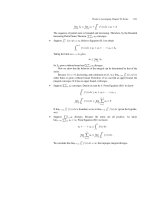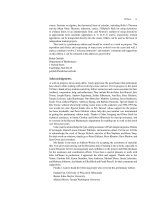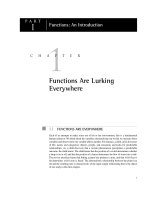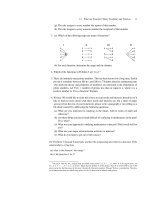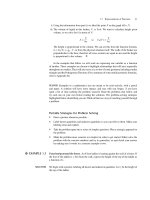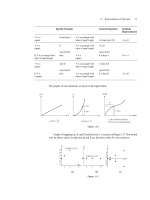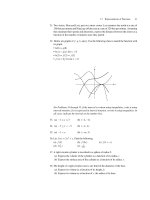Calculus an applied approach 8e ron larson
Bạn đang xem bản rút gọn của tài liệu. Xem và tải ngay bản đầy đủ của tài liệu tại đây (19.45 MB, 930 trang )
Applications
Business and Economics
Account balances, 302, 668, 692
Advertising awareness, A36
Advertising costs, 195, 719
Annual operating costs, 7
Annual salary, 68
Annuity, 18, 390, 393, 415, 677, 682,
A33
Average cost, 233, 252, 261, 265, 388,
719
Average cost and profit, 289
Average production, 560
Average profit, 265, 558
Average revenue, 560
Average salary for public school nurses,
380
Average weekly demand, 645
Average weekly profit, 560
Average yield, U.S. Treasury bonds, 727
Bolts produced by a foundry, 381
Break-even analysis, 54, 68, 110
Break-even point, 49, 55
Budget analysis, 671
Budget deficit, 401
Budget variance, 12
Capital accumulation, 393
Capital campaign, 428
Capitalized cost, 469, 476
Cash flow, 373
Cash flow per share
Energizer Holdings, 62
Harley-Davidson, 339
Ruby Tuesday, 62
Certificate of deposit, 307
Charitable foundation, 469
Choosing a job, 67
Cobb-Douglas production function,
187, 500, 503, 514, 528, 560
College tuition fund, 428
Compact disc shipments, 287
Complementary and substitute products,
514
Compound interest, 18, 93, 101, 104,
173, 306, 315, 316, 324, 338,
342, 349, 393, 415, 670, 724, 725
Construction, 41, 534
Consumer and producer surplus, 398,
401, 402, 416, 417, 448
Cost, 58, 80, 81, 99, 137, 163, 214,
224, 265, 274, 361, 363, 364,
373, 393, 413, 414, 524, 533,
618, 654, 671, 719
Cost increases, 658
Cost, revenue, and profit, 81, 194, 202,
402
Pixar, 109
Credit card rate, 173
Daily morning newspapers, number of,
541
Demand, 80, 110, 145, 146, 151, 152,
162, 163, 185, 187, 254, 282,
290, 306, 324, 333, 348, 363,
380, 427, 543, 644, 653, 654
Demand function, 373, 509
Depreciation, 64, 67, 110, 173, 298,
315, 351, 393, 683, 725
Diminishing returns, 231, 244
Doubling time, 322, 324, 352
Dow Jones Industrial Average, 41, 152,
234
Earnings per share
Home Depot, 477
Starbucks, 504
Earnings per share, sales, and shareholder’s equity, PepsiCo, 544
Economics, 151
equation of exchange, 566
gross domestic product, 282
investment, 637
marginal benefits and costs, 364
Pareto’s Law, A30
present value, 474
revenue, 290
Economy, contour map, 499
Effective rate of interest, 303, 306, 349
Effective yield, 342
Elasticity of demand, 253, A35
Elasticity and revenue, 250
Endowment, 469
Equilibrium point, 50, 113
Equimarginal Rule, 533
Expected sales, 631
Farms, number of, 113
Federal debt, 671
Federal education spending, 55
Finance, 24, 325
annuity, 683
compound interest, 724
cyclical stocks, 599
present value, 474
Fuel cost, 152, 399
Future value, 306, 428
Hourly wage, 350, 539
Income
median, 544
personal, 67, 636
Income distribution, 402
Increasing production, 193
Individual retirement account, 670
Inflation rate, 298, 316, 351, 671
Installment loan, 32
Insurance, 636
www.pdfgrip.com
Interval of inelasticity, 291
Inventory, 32, 617, 659
cost, 233, 289
management, 104, 152
replenishment, 163
Investment, 504, 515, 670, A23, A35,
A41, A43
Rule of 70, 342
strategy, 534
Job offer, 401
Least-Cost Rule, 533
Lifetime of a product, 641
Linear depreciation, 64, 66, 67, 110
Lorenz curve, 402
Managing a store, 163
Manufacturing, 12, 654
Marginal analysis, 277, 278, 282, 393,
457
Marginal cost, 150, 151, 152, 202, 381,
514, 567
Marginal productivity, 514
Marginal profit, 144, 148, 150, 151,
152, 202, 203
Marginal revenue, 147, 150, 151, 202,
514, 567
Market analysis, 637
Market equilibrium, 81
Market stabilization, 679, 725
Marketing, 437, A23
Maximum production level, 528, 529,
567, 569
Maximum profit, 222, 248, 252, 253,
520, 530
Maximum revenue, 245, 247, 253, 312
Mean and median useful lifetimes of a
product, 648
Minimum average cost, 246, 333, 334
Minimum cost, 241, 242, 243, 253,
254, 288, 525, 567
Monthly payments, 501, 504
Mortgage debt, 393
Multiplier effect, tax rebate, 725
National debt, 112
National income, A27
Negotiating a price, 162
Number of Kohl’s stores, 449
Number of operating federal credit
unions, 671
Office space, 534
Owning
a business, 80
a franchise, 104
Point of diminishing returns, 231, 233,
288
Present value, 304, 306, 349, 424, 425,
428, 449, 457, 469, 474, 476
of a perpetual annuity, 467
Producer and consumer surplus, 398,
401, 402, 416, 417, 448
Production, 12, 187, 413, 500, 503,
533, 726
Production level, 6, 24
Productivity, 233
Profit, 7, 24, 67, 81, 93, 104, 151, 152,
164, 192, 195, 202, 203, 204,
214, 224, 243, 274, 281, 288,
289, 343, 364, 387, 415, 503,
524, 567, 711
Affiliated Computer Services, 351
Bank of America, 351
CVS Corporation, 42
The Hershey Company, 448
Walt Disney Company, 42
Profit analysis, 67, 212, 214
Property value, 298, 348
Purchasing power of the dollar, 448
Quality control, 11, 12, 162, 469, 635,
658
Real estate, 80, 568
Reimbursed expenses, 68
Retail values of motor homes, 180
Returning phone calls, 655
Revenue, 81, 150, 151, 254, 281, 288,
343, 380, 401, 413, 428, 448,
523, 524, 567, 636, 659
California Pizza Kitchen, 348
CVS Corporation, 42
EarthLink, 544
eBay, 683
Men’s Wearhouse, 416
Microsoft, 134
Papa John’s, 254, 349
Polo Ralph Lauren, 123, 137
Sonic Corporation, 343
Symantec, 438
of symphony orchestras, 352
Telephone & Data Systems, U.S.
Cellular, and IDT, 416
Walt Disney Company, 42
Revenue per share
McDonald’s, 134
Target, 343
U.S. Cellular, 170
Walt Disney Company, 290
Salary, 671, 683, 725
Salary contract, 104, 112
Sales, 7, 195, 234, 340, 343, 380, 474,
589, 598, 599, 600, 659, 671,
682, 724, A30, A35
Avon Products, 307, 416
Bausch & Lomb, 204
Best Buy, 109
Dillard’s, 51
Dollar General, 51
of e-commerce companies, 334
of exercise equipment, 343
of gasoline, 152
Home Depot, 200, 201
Kohl’s, 51
PetSmart, 417
of plasma televisions, 67
Procter & Gamble, 254
Safeway, 625
Scotts Miracle-Gro, 124, 137
Starbucks, 38, 298
Whirlpool, 38
Sales analysis, 163
Sales, equity, and earnings per share,
Johnson & Johnson, 566
Sales growth, 233, A19, A41, A42
Sales per share
CVS Corporation, 164
Dollar Tree, 170
Lowe’s, 254
Scholarship fund, 469
Seasonal sales, 605, 617, 618, 624,
625, 626
Shareholder’s equity, Wal-Mart, 504,
515
Social Security benefits, 274
Social Security Trust Fund, 402
Stock price, 12
Substitute and complementary products,
514
Supply and demand, 54, 110, A35
Supply function, 373
Surplus, 398, 401, 402, 416, 417, 448
Testing for defective units, 656
Trade deficit, 149
Tripling time, 324
Trust fund, 306
Union negotiation, 66
Useful life
of an appliance, 653
of a battery, 644, 653, 654
of a component in a machine, 644
of a mechanical unit, 660
of a tire, 654
Wages, 654, 660
Weekly demand, 642
Weekly salary, 55
Life Sciences
Animal shelter, 534
Biology
bacterial culture, 173, 307, 380, 437,
534
bee population, 449
www.pdfgrip.com
cell division, 307, 671
cell growth, A30
child gender, 635
deer population, 435
endangered species population, 348,
437
fertility rates, 224
fish population, 349
fishing quotas, 393
gestation period of rabbits, 104
growth of a red oak tree, 288
hybrid selection, A39, A42
internal organ size, A43
invertebrate species, 109
plant growth, 608
population growth, 152, 162, 300,
337, 342, 438, 448, 670, A38, A42
predator-prey cycle, 594, 598, 599
ring-necked pheasant population, 474
stocking a lake with fish, 524
trout population, 380
weights of adult male rhesus monkeys,
651
weights of male collies, 12
wildlife management, 265, 282, A23
Biorhythms, 595, 598
Botany, 660
Environment
carbon dioxide, 670
contour map of the ozone hole, 498
oxygen level in a pond, 162, 287
pollutant level, 173
pollutant removal, 93, 265, 438
pollutant in a river, 683
size of an oil slick, 195
smokestack emission, 262
Environmental cost, pollutant removal,
104
Forestry, 343, 719
Doyle Log Rule, 203
Hardy-Weinberg Law, 524, 533
Health
AIDS cases, 637
blood pressure, 598
body temperature, 151
ear infections treated by doctors, 42
epidemic, 402, 437
exposure to a carcinogen and
mortality, 569
exposure to sun, 289
heights of American men, 660
infant mortality, 543
nutrition, 534
percents of adults who are drinkers
or smokers, 42
spread of a disease, A35
U.S. HIV/AIDS epidemic, 187
velocity of air flow into and out of
the lungs, 598, 618
Heights of members of a population, 12
Maximum yield of apple trees, 242
Medical science
drug concentration, 351, A43
length of pregnancy, 654
surface area of a human body, 567
velocity of air during coughing, 224
volume of air in the lungs, 415
Medicine
amount of drug in bloodstream, 150,
200
days until recovery after a medical
procedure, 654, 659
drug absorption, 458
drug concentration in bloodstream,
139, 282, 458, 719
duration of an infection, 524
effectiveness of a pain-killing drug,
150, 290
heart transplants, 660
kidney transplants, 55
Poiseuille’s Law, 288
prescription drugs, 80
spread of a virus, 234, 349
temperature of a patient, 81, 589
treatment of a bacterial infection, 567
Physiology
blood flow, 393
body surface area, 282
heart rate, 7
Systolic blood pressure, 160
Tree growth, 364
Social and Behavioral Science
Computers and Internet users, 544
Construction workers, 617
Consumer awareness
average costs per day for a hospital
room, 671
cellular phone charges, 112
change in beef prices, 415
cost of photocopies, 112
credit card fraud, 634
fuel mileage, 307, 654
home mortgage, 334, 350
magazine subscription, 477
median sales prices of homes, 298
overnight delivery charges, 104
price of gasoline, 415
price of ground beef, 163
price of ice cream, 202
prices of homes in the South, 180
rent for an apartment, 67
U.S. Postal Service first class mail
rates, 104
weekly food costs for a family of
four, 671
Consumer trends
amount spent on snowmobiles, 35
basic cable television subscribers, 41
cars per household, 659
cellular telephone subscribers, 41,
200, 201, 539
consumption of bottled water, 207
consumption of Italian cheeses, 207
consumption of milk, 495, 515
consumption of petroleum, 399
consumption of pineapples, 402
coupons used in a grocery store, 654
energy consumption, 617
health services and supplies, 541
hours of TV usage, 288
lumber use, 458
magazine subscribers, 458
marginal utility, 515
multiplier effect, spending in a
resort city, 683
textbook spending, 55
visitors to a national park, 124, 150
Cost of seizing an illegal drug, 195
Education, 637
ACT scores, 654
exam scores, 653
quiz scores, 658
Employment, 315
amusement park workers, 608
construction workers, 598, 608
Enrollment at public colleges, 35
Farm work force, 55
Health insurance coverage status, 637
Internet users, 364
and computers, 544
Marginal propensity to consume, 371,
373
Medical degrees, number of, 214
Newspaper circulation, 288
Population
of California, 109
of the District of Columbia, 244
of Las Vegas, Nevada, 307
of Missouri, 68
of South Carolina, 66
of Texas, 109
of the United States, 224, 343
Population density, 557, 560
contour map of New York, 566
Population growth, 351, 352, A41, A43
Horry County, South Carolina, 364
Houston, Texas, 324
Japan, 151
www.pdfgrip.com
Orlando, Florida, 324
United States, 298, 438
world, 544
Population per square mile of the
United States, 18
Psychology
Ebbinghaus Model, 315
learning curve, 265, 343
learning theory, 307, 315, 325, 334,
644, 653, A30, A42
memory model, 428
migraine prevalence, 137
rate of change, 329
sleep patterns, 416
Stanford-Binet Test (IQ test), 515
Queuing model, 503
Recycling, 112, 202
Research and development, 149, 692
School enrollment, 342
Seizing drugs, 265
Unemployed workers, 109
Vital statistics
married couples, rate of increase, 364
median age, 458
numbers of children in families, 659
people 65 years old and over, 349
Women in the work force, 568
Work groups, 655
Physical Sciences
Acceleration, 176
Acceleration due to gravity,
on Earth, 177
on the moon, 177
Arc length, 458, 578
Area, 194, 242, 243, 282
of a pasture, 241
Average elevation, 568
Average velocity, 140
Beam strength, 243
Biomechanics, Froude number, 566
Building dimensions, 41
Catenary, 311
Changing area, 189
Changing volume, 191
Chemistry
acidity of rainwater, 566
boiling temperature of water, 333
carbon dating, 325, 342
chemical mixture, A40, A42
chemical reaction, A37, A42
dating organic material, 294
evaporation rate, A43
finding concentrations, 24
hydrogen orbitals, 660
(continued on back endsheets)
This page intentionally left blank
www.pdfgrip.com
Calculus
An Applied Approach
www.pdfgrip.com
This page intentionally left blank
www.pdfgrip.com
Calculus
An Applied Approach
RON LARSON
The Pennsylvania State University
The Behrend College
Eighth Edition
with the assistance of
D AV I D C . FA LV O
The Pennsylvania State University
The Behrend College
Australia • Brazil • Japan • Korea • Mexico • Singapore • Spain • United Kingdom • United States
www.pdfgrip.com
Calculus: An Applied Approach, Eighth Edition
Ron Larson
Publisher: Richard Stratton
Sponsoring Editor: Cathy Cantin
Senior Marketing Manager: Jennifer Jones
Development Editor: Peter Galuardi
Art and Design Manager: Jill Haber
Cover Design Manager: Anne S. Katzeff
Senior Photo Editor: Jennifer Meyer Dare
Senior Composition Buyer: Chuck Dutton
Senior New Title Project Manager: Pat O’Neill
Editorial Associate: Jeannine Lawless
© 2009 Brooks/Cole, Cengage Learning
ALL RIGHTS RESERVED. No part of this work covered by the copyright
herein may be reproduced, transmitted, stored or used in any form or by
any means graphic, electronic, or mechanical, including but not limited to
photocopying, recording, scanning, digitizing, taping, Web distribution,
information networks, or information storage and retrieval systems, except
as permitted under Section 107 or 108 of the 1976 United States Copyright
Act, without the prior written permission of the publisher.
For product information and technology assistance, contact us at
Cengage Learning Customer & Sales Support, 1-800-354-9706
For permission to use material from this text or product, submit all
requests online at www.cengage.com/permissions
Further permissions questions can be emailed to
Marketing Associate: Mary Legere
Editorial Assistant: Jill Clark
Library of Congress Control Number: 2007925596
Cover photo © Digital Vision Photography
For orders, use student text ISBNs
ISBN-10: 0-618-95825-8
ISBN-13: 978-0-618-95825-2
Brooks/Cole
20 Davis Drive
Belmont, CA 94002
USA
Cengage Learning is a leading provider of customized learning solutions
with office locations around the globe, including Singapore, the United
Kingdom, Australia, Mexico, Brazil, and Japan. Locate your local office at:
international.cengage.com/region
Cengage Learning products are represented in Canada by Nelson
Education, Ltd.
For your course and learning solutions, visit
academic.cengage.com
Purchase any of our products at your local college store or at our preferred
online store www.ichapters.com
Printed in the United States of America
23456789–DOW–11 10 09 08
www.pdfgrip.com
v
Contents
Contents
A Word from the Author (Preface)
A Plan for You as a Student xi
Features xv
0
A Precalculus Review
0.1
0.2
0.3
0.4
0.5
1
ix
1
The Real Number Line and Order 2
Absolute Value and Distance on the Real Number Line
Exponents and Radicals 13
Factoring Polynomials 19
Fractions and Rationalization 25
Functions, Graphs, and Limits
33
1.1 The Cartesian Plane and the Distance Formula
1.2 Graphs of Equations 43
1.3 Lines in the Plane and Slope 56
Mid-Chapter Quiz 68
1.4 Functions 69
1.5 Limits 82
1.6 Continuity 94
Chapter 1 Algebra Review 105
Chapter Summary and Study Strategies 107
Review Exercises 109
Chapter Test 113
2
Differentiation
2.1 The Derivative and the Slope of a Graph
2.2 Some Rules for Differentiation 126
2.3 Rates of Change: Velocity and Marginals
2.4 The Product and Quotient Rules 153
Mid-Chapter Quiz 164
2.5 The Chain Rule 165
2.6 Higher-Order Derivatives 174
2.7 Implicit Differentiation 181
2.8 Related Rates 188
Chapter 2 Algebra Review 196
Chapter Summary and Study Strategies 198
Review Exercises 200
Chapter Test 204
www.pdfgrip.com
8
34
114
115
138
vi
Contents
3
Applications of the Derivative
205
3.1 Increasing and Decreasing Functions 206
3.2 Extrema and the First-Derivative Test 215
3.3 Concavity and the Second-Derivative Test 225
3.4 Optimization Problems 235
Mid-Chapter Quiz 244
3.5 Business and Economics Applications 245
3.6 Asymptotes 255
3.7 Curve Sketching: A Summary 266
3.8 Differentials and Marginal Analysis 275
Chapter 3 Algebra Review 283
Chapter Summary and Study Strategies 285
Review Exercises 287
Chapter Test 291
4
Exponential and Logarithmic Functions
292
4.1 Exponential Functions 293
4.2 Natural Exponential Functions 299
4.3 Derivatives of Exponential Functions 308
Mid-Chapter Quiz 316
4.4 Logarithmic Functions 317
4.5 Derivatives of Logarithmic Functions 326
4.6 Exponential Growth and Decay 335
Chapter 4 Algebra Review 344
Chapter Summary and Study Strategies 346
Review Exercises 348
Chapter Test 352
5
Integration and Its Applications
Antiderivatives and Indefinite Integrals 354
Integration by Substitution and the
General Power Rule 365
5.3 Exponential and Logarithmic Integrals 374
Mid-Chapter Quiz 381
5.4 Area and the Fundamental Theorem of Calculus 382
5.5 The Area of a Region Bounded by Two Graphs 394
5.6 The Definite Integral as the Limit of a Sum 403
Chapter 5 Algebra Review 409
Chapter Summary and Study Strategies 411
Review Exercises 413
Chapter Test 417
5.1
5.2
www.pdfgrip.com
353
Contents
6
Techniques of Integration
vii
418
6.1 Integration by Parts and Present Value 419
6.2 Partial Fractions and Logistic Growth 429
6.3 Integration Tables 439
Mid-Chapter Quiz 449
6.4 Numerical Integration 450
6.5 Improper Integrals 459
Chapter 6 Algebra Review 470
Chapter Summary and Study Strategies 472
Review Exercises 474
Chapter Test 477
7
Functions of Several Variables
478
7.1 The Three-Dimensional Coordinate System 479
7.2 Surfaces in Space 487
7.3 Functions of Several Variables 496
7.4 Partial Derivatives 505
7.5 Extrema of Functions of Two Variables 516
Mid-Chapter Quiz 525
7.6 Lagrange Multipliers 526
7.7 Least Squares Regression Analysis 535
7.8 Double Integrals and Area in the Plane 545
7.9 Applications of Double Integrals 553
Chapter 7 Algebra Review 561
Chapter Summary and Study Strategies 563
Review Exercises 565
Chapter Test 569
8
Trigonometric Functions
8.1 Radian Measure of Angles 571
8.2 The Trigonometric Functions 579
8.3 Graphs of Trigonometric Functions 590
Mid-Chapter Quiz 600
8.4 Derivatives of Trigonometric Functions 601
8.5 Integrals of Trigonometric Functions 610
Chapter 8 Algebra Review 619
Chapter Summary and Study Strategies 621
Review Exercises 623
Chapter Test 626
www.pdfgrip.com
570
viii
Contents
9
Probability and Calculus
627
9.1 Discrete Probability 628
9.2 Continuous Random Variables 638
9.3 Expected Value and Variance 645
Chapter 9 Algebra Review 655
Chapter Summary and Study Strategies 657
Review Exercises 658
Chapter Test 661
10
Series and Taylor Polynomials
662
10.1 Sequences 663
10.2 Series and Convergence 672
10.3 p-Series and the Ratio Test 684
Mid-Chapter Quiz 692
10.4 Power Series and Taylor's Theorem 693
10.5 Taylor Polynomials 703
10.6 Newton's Method 712
Chapter 10 Algebra Review 720
Chapter Summary and Study Strategies 722
Review Exercises 724
Chapter Test 727
Appendices
Appendix A:
Appendix B:
B.1
B.2
Alternative Introduction to the
Fundamental Theorem of Calculus
Formulas A10
Differentiation and Integration Formulas A10
Formulas from Business and Finance A14
Appendix C: Differential Equations
C.1
C.2
C.3
C.4
A1
A17
Solutions of Differential Equations A17
Separation of Variables A24
First-Order Linear Differential Equations A31
Applications of Differential Equations A36
Appendix D: Properties and Measurement (web only)*
D.1
D.2
Review of Algebra, Geometry, and Trigonometry
Units of Measurements
Appendix E: Graphing Utility Programs (web only)*
E.1
Graphing Utility Programs
Answers to Selected Exercises A45
Answers to Checkpoints A139
Index A155
*Available at the text-specific website at
college.cengage.com/pic/larsonCAA8e
www.pdfgrip.com
A Word from the Author
ix
A Word from the Author
Welcome to Calculus: An Applied Approach, Eighth Edition. In this revision, I
focused not only on providing a meaningful revision to the text, but also a
completely integrated learning program. Applied calculus students are a diverse
group with varied interests and backgrounds. The revision strives to address the
diversity and the different learning styles of students. I also aimed to
alleviate and remove obstacles that prevent students from mastering the material.
An Enhanced Text
The table of contents was streamlined to enable instructors to spend more time on
each topic. This added time will give students a better understanding of the
concepts and help them to master the material.
Real data and applications were updated, rewritten, and added to address more
modern topics, and data was gathered from news sources, current events,
industry, world events, and government. Exercises derived from other disciplines’
textbooks are included to show the relevance of the calculus to students’ majors.
I hope these changes will give students a clear picture that the math they are
learning exists beyond the classroom.
Two new chapter tests were added: a Mid-Chapter Quiz and a Chapter Test.
The Mid-Chapter quiz gives students the opportunity to discover any topics they
might need to study further before they progress too far into the chapter. The
Chapter Test allows students to identify and strengthen any weaknesses in
advance of an exam.
Several new section-level features were added to promote further mastery of
the concepts.
■
Concept Checks appear at the end of each section, immediately before the
exercise sets. They ask non-computational questions designed to test students’
basic understanding of that sections’ concepts.
■
Make a Decision exercises and examples ask open-ended questions that force
students to apply concepts to real-world situations.
■
Extended Applications are more in-depth, applied exercises requiring students
to work with large data sets and often involve work in creating or analyzing
models.
I hope the combination of these new features with the existing features will
promote a deeper understanding of the mathematics.
Enhanced Resources
Although the textbook often forms the basis of the course, today’s students often
find greater value in an integrated text and technology program. With that in
mind, I worked with the publisher to enhance the online and media resources
available to students, to provide them with a complete learning program.
www.pdfgrip.com
x
A Word from the Author
An online course has been developed with dynamic, algorithmic exercises tied
to exercises within the text. These exercises provide students with unlimited practice for complete mastery of the topics.
An additional resource for the 8th edition is a Multimedia Online eBook. This
eBook breaks the physical constraints of a traditional text and binds a number of
multimedia assets and features to the text itself. Based in Flash, students can read
the text, watch the videos when they need extra explanation, view enlarged math
graphs, and more. The eBook promotes multiple learning styles and provides
students with an engaging learning experience.
For students who work best in groups or whose schedules don’t allow them to
come to office hours, Calc Chat is now available with this edition. Calc Chat
(located at www.CalcChat.com) provides solutions to exercises. Calc Chat also
has a moderated online forum for students to discuss any issues they may be
having with their calculus work.
I hope you enjoy the enhancements made to the eighth edition. I believe the
whole suite of learning options available to students will enable any student to
master applied calculus.
Ron Larson
www.pdfgrip.com
A Plan for You as a Student
xi
A Plan for You as a Student
Study Strategies
Your success in mathematics depends on your active participation both in class and outside of class. Because the
material you learn each day builds on the material you have learned previously, it is important that you keep up with your
course work every day and develop a clear plan of study. This set of guidelines highlights key study strategies to help
you learn how to study mathematics.
Preparing for Class The syllabus your instructor provides is an invaluable resource that outlines the major topics to be
covered in the course. Use it to help you prepare. As a general rule, you should set aside two to four hours of study time
for each hour spent in class. Being prepared is the first step toward success. Before class:
■ Review your notes from the previous class.
■ Read the portion of the text that will be covered in class.
Keeping Up Another important step toward success in mathematics involves your ability to keep up with the work. It
is very easy to fall behind, especially if you miss a class. To keep up with the course work, be sure to:
■
■
■
Attend every class. Bring your text, a notebook, a pen or pencil, and a calculator (scientific or graphing). If you miss a
class, get the notes from a classmate as soon as possible and review them carefully.
Participate in class. As mentioned above, if there is a topic you do not understand, ask about it before the instructor
moves on to a new topic.
Take notes in class. After class, read through your notes and add explanations so that your notes make sense to you.
Fill in any gaps and note any questions you might have.
Getting Extra Help It can be very frustrating when you do not understand concepts and are unable to complete
homework assignments. However, there are many resources available to help you with your studies.
■ Your instructor may have office hours. If you are feeling overwhelmed and need help, make an appointment to discuss
your difficulties with your instructor.
■ Find a study partner or a study group. Sometimes it helps to work through problems with another person.
■ Special assistance with algebra appears in the Algebra Reviews, which appear throughout each chapter. These short
reviews are tied together in the larger Algebra Review section at the end of each chapter.
Preparing for an Exam The last step toward success in mathematics lies in how you prepare for and complete exams.
If you have followed the suggestions given above, then you are almost ready for exams. Do not assume that you can cram
for the exam the night before—this seldom works. As a final preparation for the exam:
■ When you study for an exam, first look at all definitions, properties, and formulas until you know them. Review
your notes and the portion of the text that will be covered on the exam. Then work as many exercises as you can,
especially any kinds of exercises that have given you trouble in the past, reworking homework problems as necessary.
■ Start studying for your exam well in advance (at least a week). The first day or two, study only about two hours.
Gradually increase your study time each day. Be completely prepared for the exam two days in advance. Spend the
final day just building confidence so you can be relaxed during the exam.
For a more comprehensive list of study strategies, please visit college.cengage.com/pic/larsonCAA8e.
www.pdfgrip.com
xii
Supplements
Get more value from your textbook!
Supplements for the Instructor
Supplements for the Student
Digital Instructor’s Solution Manual
Found on the instructor website, this manual contains the
complete, worked-out solutions for all the exercises in the
text.
Student Solutions Guide
This guide contains complete solutions to all
odd-numbered exercises in the text.
Excel Made Easy CD
This CD uses easy-to-follow videos to help students
master mathematical concepts introduced in class.
Electronic spreadsheets and detailed tutorials are included.
Instructor and Student Websites
The Instructor and Student websites at college.cengage.com/pic/larsonCAA8e contain an abundance of resources for
teaching and learning, such as Note Taking Guides, a Graphing Calculator Guide, Digital Lessons, ACE Practice
Tests, and a graphing calculator simulator.
Instruction DVDs
Hosted by Dana Mosely and captioned for the hearing-impaired, these DVDs cover all sections in the text. Ideal for
promoting individual study and review, these comprehensive DVDs also support students in online courses or those
who have missed a lecture.
The Online Study Center
The Online Study Center encompasses the interactive online products and services integrated with Cengage Learning
mathematics programs. Students and instructors can access Online Study Center content through text-specific Student
and Instructor websites and via online learning platforms including WebAssign as well as Blackboard®, WebCT®,
and other course management systems.
Diploma Testing
Diploma Testing provides instructors with a wide array of algorithmic items along with improved functionality and
ease of use. Diploma Testing offers all the tools needed to create, deliver, and customize multiple types
of tests—including authoring and editing algorithmic questions. In addition to producing an unlimited number of tests
for each chapter, including cumulative tests and final exams, Diploma Testing also offers instructors the ability to
deliver tests online, or by paper and pencil.
Online Course Content for Blackboard®, WebCT®, and eCollege®
Deliver program or text-specific Cengage Learning content online using your institution’s local course management
system. Cengage Learning offers homework, tutorials, videos, and other resources formatted for Blackboard®,
WebCT®, eCollege®, and other course management systems. Add to an existing online course or create a new one
by selecting from a wide range of powerful learning and instructional materials.
www.pdfgrip.com
Acknowledgments
xiii
Acknowledgments
I would like to thank the many people who have helped me at various stages of
this project during the past 27 years. Their encouragement, criticisms, and
suggestions have been invaluable.
Thank you to all of the instructors who took the time to review the changes to
this edition and provide suggestions for improving it. Without your help this book
would not be possible.
Reviewers of the Eighth Edition
Lateef Adelani, Harris-Stowe State University, Saint Louis; Frederick Adkins,
Indiana University of Pennsylvania; Polly Amstutz, University of Nebraska at
Kearney; Judy Barclay, Cuesta College; Jean Michelle Benedict, Augusta State
University; Ben Brink, Wharton County Junior College; Jimmy Chang,
St. Petersburg College; Derron Coles, Oregon State University; David French,
Tidewater Community College; Randy Gallaher, Lewis & Clark Community
College; Perry Gillespie, Fayetteville State University; Walter J. Gleason,
Bridgewater State College; Larry Hoehn, Austin Peay State University; Raja
Khoury, Collin County Community College; Ivan Loy, Front Range Community
College; Lewis D. Ludwig, Denison University; Augustine Maison, Eastern
Kentucky University; John Nardo, Oglethorpe University; Darla Ottman,
Elizabethtown Community & Technical College; William Parzynski, Montclair
State University; Laurie Poe, Santa Clara University; Adelaida Quesada, Miami
Dade College—Kendall; Brooke P. Quinlan, Hillsborough Community College;
David Ray, University of Tennessee at Martin; Carol Rychly, Augusta State
University; Mike Shirazi, Germanna Community College; Rick Simon,
University of La Verne; Marvin Stick, University of Massachusetts—Lowell;
Devki Talwar, Indiana University of Pennsylvania; Linda Taylor, Northern
Virginia Community College; Stephen Tillman, Wilkes University; Jay Wiestling,
Palomar College; John Williams, St. Petersburg College; Ted Williamson,
Montclair State University
Reviewers of the Seventh Edition
George Anastassiou, University of Memphis; Keng Deng, University of Louisiana
at Lafayette; Jose Gimenez, Temple University; Shane Goodwin, Brigham Young
University of Idaho; Harvey Greenwald, California Polytechnic State University;
Bernadette Kocyba, J. Sergeant Reynolds Community College; Peggy Luczak,
Camden County College; Randall McNiece, San Jacinto College; Scott Perkins,
Lake Sumter Community College
Reviewers of Previous Editions
Carol Achs, Mesa Community College; David Bregenzer, Utah State University;
Mary Chabot, Mt. San Antonio College; Joseph Chance, University of Texas—Pan
American; John Chuchel, University of California; Miriam E. Connellan,
Marquette University; William Conway, University of Arizona; Karabi Datta,
Northern Illinois University; Roger A. Engle, Clarion University of
Pennsylvania; Betty Givan, Eastern Kentucky University; Mark Greenhalgh,
www.pdfgrip.com
xiv
Acknowledgments
Fullerton College; Karen Hay, Mesa Community College; Raymond Heitmann,
University of Texas at Austin; William C. Huffman, Loyola University of
Chicago; Arlene Jesky, Rose State College; Ronnie Khuri, University of Florida;
Duane Kouba, University of California—Davis; James A. Kurre, The
Pennsylvania State University; Melvin Lax, California State University—Long
Beach; Norbert Lerner, State University of New York at Cortland; Yuhlong Lio,
University of South Dakota; Peter J. Livorsi, Oakton Community College; Samuel
A. Lynch, Southwest Missouri State University; Kevin McDonald, Mt. San
Antonio College; Earl H. McKinney, Ball State University; Philip R.
Montgomery, University of Kansas; Mike Nasab, Long Beach City College;
Karla Neal, Louisiana State University; James Osterburg, University of
Cincinnati; Rita Richards, Scottsdale Community College; Stephen B. Rodi,
Austin Community College; Yvonne Sandoval-Brown, Pima Community College;
Richard Semmler, Northern Virginia Community College—Annandale; Bernard
Shapiro, University of Massachusetts—Lowell; Jane Y. Smith, University of
Florida; DeWitt L. Sumners, Florida State University; Jonathan Wilkin,
Northern Virginia Community College; Carol G. Williams, Pepperdine
University; Melvin R. Woodard, Indiana University of Pennsylvania; Carlton
Woods, Auburn University at Montgomery; Jan E. Wynn, Brigham Young
University; Robert A. Yawin, Springfield Technical Community College; Charles
W. Zimmerman, Robert Morris College
My thanks to David Falvo, The Behrend College, The Pennsylvania State
University, for his contributions to this project. My thanks also to Robert
Hostetler, The Behrend College, The Pennsylvania State University, and Bruce
Edwards, University of Florida, for their significant contributions to previous
editions of this text.
I would also like to thank the staff at Larson Texts, Inc. who assisted with
proofreading the manuscript, preparing and proofreading the art package, and
checking and typesetting the supplements.
On a personal level, I am grateful to my spouse, Deanna Gilbert Larson, for
her love, patience, and support. Also, a special thanks goes to R. Scott O’Neil.
If you have suggestions for improving this text, please feel free to write to me.
Over the past two decades I have received many useful comments from both
instructors and students, and I value these comments very highly.
Ron Larson
www.pdfgrip.com
xv
Features
How to get the most out of your textbook . . .
CHAPTER OPENERS
2
Differentiation
© Schlegelmilch/Corbis
Each opener has an applied example of a core
topic from the chapter. The section outline
provides a comprehensive overview of the
material being presented.
2.1
2.2
2.3
2.4
2.5
2.6
2.7
2.8
The Derivative and
the Slope of a Graph
Some Rules for
Differentiation
Rates of Change:
Velocity and
Marginals
The Product and
Quotient Rules
The Chain Rule
Higher-Order
Derivatives
Implicit
Differentiation
Related Rates
Higher-order derivatives are used to determine the acceleration function of a
sports car. The acceleration function shows the changes in the car’s velocity. As
the car reaches its “cruising”speed, is the acceleration increasing or decreasing?
(See Section 2.6, Exercise 45.)
Applications
Differentiation has many real-life applications. The applications
listed below represent a sample of the applications in this chapter.
■
■
■
■
■
Sales, Exercise 61, page 137
Political Fundraiser, Exercise 63, page 137
Make a Decision: Inventory Replenishment, Exercise 65,
page 163
Modeling Data, Exercise 51, page 180
Health: U.S. HIV/AIDS Epidemic, Exercise 47, page 187
114
SECTION 2.1
The Derivative and the Slope of a Graph
115
Section 2.1
■ Identify tangent lines to a graph at a point.
The Derivative
and the Slope
of a Graph
■ Approximate the slopes of tangent lines to graphs at points.
■ Use the limit definition to find the slopes of graphs at points.
■ Use the limit definition to find the derivatives of functions.
■ Describe the relationship between differentiability and continuity.
Tangent Line to a Graph
y
(x3, y3)
(x2, y2)
(x4, y4)
x
(x1, y1)
F I G U R E 2 . 1 The slope of a
nonlinear graph changes from one
point to another.
Calculus is a branch of mathematics that studies rates of change of functions. In
this course, you will learn that rates of change have many applications in real life.
In Section 1.3, you learned how the slope of a line indicates the rate at which the
line rises or falls. For a line, this rate (or slope) is the same at every point on the
line. For graphs other than lines, the rate at which the graph rises or falls changes
from point to point. For instance, in Figure 2.1, the parabola is rising more
quickly at the point ͑x1, y1͒ than it is at the point ͑x2, y2 ͒. At the vertex ͑x3, y3͒, the
graph levels off, and at the point ͑x4, y4͒, the graph is falling.
To determine the rate at which a graph rises or falls at a single point, you can
find the slope of the tangent line at the point. In simple terms, the tangent line to
the graph of a function f at a point P͑x1, y1͒ is the line that best approximates the
graph at that point, as shown in Figure 2.1. Figure 2.2 shows other examples of
tangent lines.
www.pdfgrip.com
SECTION
OBJECTIVES
A bulleted list of learning
objectives allows you the
opportunity to preview what
will be presented in the
upcoming section.
xvi
Features
NEW!
MAKE A DECISION
Multi-step exercises reinforce your problem-solving
skills and mastery of concepts, as well as taking a
real-life application further by testing what you know
about a given problem to make a decision within the
context of the problem.
45. MAKE A DECISION: FUEL COST A car is driven 15,000
miles a year and gets x miles per gallon. Assume that the
average fuel cost is $2.95 per gallon. Find the annual cost
of fuel C as a function of x and use this function to
complete the table.
x
10
15
20
25
30
35
40
C
dC͞dx
g
Who would benefit more from a 1 mile per gallon increase
61. MAKE A DECISION: NEGOTIATING A PRICE You
in fuel efficiency—the driver who gets 15 miles per gallon
decide to form a partnership with another business. Your
or the driver who gets 35 miles per gallon? Explain.
business determines that the demand x for your product is
inversely proportional to the square of the price for x ≥ 5.
(a) The price is $1000 and the demand is 16 units. Find the
demand function.
(b) Your partner determines that the product costs $250 per
unit and the fixed cost is $10,000. Find the cost
function.
(c) Find the profit function and use a graphing utility to
graph it. From the graph, what price would you
negotiate with your partner for this product? Explain
your reasoning.
CONCEPT CHECK
1. What is the name of the line that best approximates the slope of a graph
at a point?
2. What is the name of a line through the point of tangency and a second
point on the graph?
3. Sketch a graph of a function whose derivative is always negative.
4. Sketch a graph of a function whose derivative is always positive.
NEW!
CONCEPT
CHECK
These non-computational
questions appear at the end
of each section and are designed
to check your understanding
of the concepts covered in that
section.
www.pdfgrip.com
Features
xvii
The Sum and Difference Rules
DEFINITIONS AND THEOREMS
The derivative of the sum or difference of two differentiable functions is the
sum or difference of their derivatives.
All definitions and theorems are highlighted
for emphasis and easy recognition.
d
͓ f ͑x) ϩ g͑x͔͒ ϭ fЈ͑x͒ ϩ gЈ͑x͒
dx
Sum Rule
d
͓ f ͑x͒ Ϫ g͑x͔͒ ϭ fЈ͑x͒ Ϫ gЈ͑x͒
dx
Difference Rule
Definition of Average Rate of Change
If y ϭ f ͑x͒, then the average rate of change of y with respect to x on the
interval ͓a, b͔ is
Average rate of change ϭ
ϭ
f ͑b͒ Ϫ f ͑a͒
bϪa
⌬y .
⌬x
Note that f ͑a͒ is the value of the function at the left endpoint of the interval,
f ͑b͒ is the value of the function at the right endpoint of the interval, and
b Ϫ a is the width of the interval, as shown in Figure 2.18.
x
1
Example 9
y g(x) = − 2 x 4 + 3x 3 − 2x
60
Using the Sum and Difference Rules
Find an equation of the tangent line to the graph of
50
1
g͑x͒ ϭ Ϫ x 4 ϩ 3x 3 Ϫ 2x
2
40
30
at the point ͑Ϫ1, Ϫ 32 ͒.
20
Slope = 9
−3 −2
SOLUTION
x
−10
−20
1
2
3
4
5
7
(−1, − )
3
2
as shown in Figure 2.16. Using the point-slope form, you can write the equation
3
of the tangent line at ͑Ϫ1, Ϫ 2 ͒ as shown.
✓CHECKPOINT 9
32 ϭ 9͓x Ϫ ͑Ϫ1͔͒
yϪ Ϫ
an equation of the
C H A P T E R 2 Find
Differentiation
tangent line to the graph of
3x Ϫ 2 at the
f ͑x͒ ϭ Ϫx2 ϩ
Application
point ͑2, 0͒. ■
Example 10
3
Slope ϭ gЈ͑Ϫ1͒ ϭ Ϫ2͑Ϫ1͒3 ϩ 9͑Ϫ1͒2 Ϫ 2
ϭ2ϩ9Ϫ2
ϭ9
FIGURE 2.16
134
The derivative of g͑x͒ is gЈ͑x͒ ϭ Ϫ2x3 ϩ 9x2 Ϫ 2, which implies
that the slope of the graph at the point ͑Ϫ1, Ϫ 2 ͒ is
15
y ϭ 9x ϩ
2
Point-slope form
Equation of tangent line
Modeling Revenue
From 2000 through 2005, the revenue R (in millions of dollars per year) for
Microsoft Corporation can be modeled by
R ϭ Ϫ110.194t 3 ϩ 993.98t2 ϩ 1155.6t ϩ 23,036, 0 ≤ t ≤ 5
where t represents the year, with t ϭ 0 corresponding to 2000. At what rate was
Microsoft’s revenue changing in 2001? (Source: Microsoft Corporation)
Microsoft Revenue
One way to answer this question is to find the derivative of the
revenue model with respect to time.
SOLUTION
Revenue
(in millions of dollars)
R
45,000
40,000
35,000
30,000
25,000
20,000
15,000
10,000
5,000
dR
ϭ Ϫ330.582t 2 ϩ 1987.96t ϩ 1155.6, 0 ≤ t ≤ 5
dt
Ϫ330.582͑1͒2 ϩ 1987.96͑1͒ ϩ 1155.6 Ϸ 2813.
1
2
3
4
Year (0 ↔ 2000)
FIGURE 2.17
In 2001 (when t ϭ 1), the rate of change of the revenue with respect to time is
given by
Slope ≈ 2813
5
t
Because R is measured in millions of dollars and t is measured in years, it follows
that the derivative dR͞dt is measured in millions of dollars per year. So, at the end
of 2001, Microsoft’s revenue was increasing at a rate of about $2813 million per
year, as shown in Figure 2.17.
✓CHECKPOINT 10
From 1998 through 2005, the revenue per share R (in dollars) for McDonald’s
Corporation can be modeled by
R ϭ 0.0598t 2 Ϫ 0.379t ϩ 8.44,
8 ≤ t ≤ 15
where t represents the year, with t ϭ 8 corresponding to 1998. At what rate was
McDonald’s revenue per share changing in 2003? (Source: McDonald’s
Corporation) ■
www.pdfgrip.com
EXAMPLES
There are a wide variety of
relevant examples in the text,
each titled for easy reference.
Many of the solutions are
presented graphically, analytically, and/or numerically to
provide further insight into
mathematical concepts.
Examples using a real-life
situation are identified with
the
symbol.
CHECKPOINT
After each example, a similar
problem is presented to
allow for immediate practice,
and to further reinforce your
understanding of the concepts
just learned.
xviii
Features
D I S C O V E RY
These projects appear before selected topics
and allow you to explore concepts on your
own. These boxed features are optional, so
they can be omitted with no loss of continuity
in the coverage of material.
TECHNOLOGY BOXES
These boxes appear throughout the text and
provide guidance on using technology to
ease lengthy calculations, present a graphical
solution, or discuss where using technology
can lead to misleading or wrong solutions.
www.pdfgrip.com
Features
78. Credit Card Rate The average annual rate r (in percent
form) for commercial bank credit cards from 2000 through
2005 can be modeled by
TECHNOLOGY EXERCISES
Many exercises in the text can be solved with or
without technology. The
symbol identifies
exercises for which students are specifically
instructed to use a graphing calculator or
a computer algebra system to solve the
problem. Additionally, the
symbol denotes
exercises best solved by using a spreadsheet.
r ϭ ΊϪ1.7409t4 ϩ 18.070t3 Ϫ 52.68t2 ϩ 10.9t ϩ 249
where t represents the year, with t ϭ 0 corresponding to
2000. (Source: Federal Reserve Bulletin)
(a) Find the derivative of this model. Which differentiation
rule(s) did you use?
Numerical,
and
Analytic
Analysis In
(b) Use aGraphical,
graphing utility
to graph the
derivative
on the
Exercises
use a graphing utility to graph f on
interval
0 ≤ t ≤ 63–66,
5.
the interval [؊2, 2]. Complete the table by graphically
(c) Use the
trace feature
toslopes
find theof
years
thegiven points.
estimating
the
theduring
graphwhich
at the
finance
rate was
changing
theslopes
most. analytically and compare
Then
evaluate
the
your
results
those
obtained
(d) Use the
trace
featurewith
to find
the years
duringgraphically.
which the
finance rate was changing the least.
3
1
0 12 1 32 2
x
Ϫ2
Ϫ1
Ϫ2
Ϫ2
f ͑x͒
fЈ ͑x͒
63. f ͑x͒ ϭ 14x 3
64. f ͑x͒ ϭ 12x 2
(
)
65. f ͑x͒ ϭ Ϫ 12x 3
66. f ͑x͒ ϭ Ϫ 32x 2
57. Income Distribution Using the Lorenz curve in
Exercise 56 and a spreadsheet, complete the table, which
lists the percent of total income earned by each quintile in the
United States in 2005.
Quintile
Lowest
2nd
3rd
4th
Highest
Percent
Business Capsule
BUSINESS CAPSULES
AP/Wide World Photos
n 1978 Ben Cohen and Jerry Greenfield used
their combined life savings of $8000 to
convert an abandoned gas station in Burlington,
Vermont into their first ice cream shop. Today,
Ben & Jerry’s Homemade Holdings, Inc. has over
600 scoop shops in 16 countries. The company’s
three-part mission statement emphasizes
product quality, economic reward, and a
commitment to the community. Ben & Jerry’s
contributes a minimum of $1.1 million annually
through corporate philanthropy that is primarily
employee led.
I
xix
Business Capsules appear at the ends of numerous
sections. These capsules and their accompanying
exercises deal with business situations that are
related to the mathematical concepts covered in
the chapter.
73. Research Project Use your school’s library,
the Internet, or some other reference source to find
information on a company that is noted for its
philanthropy and community commitment. (One
such business is described above.) Write a short
paper about the company.
www.pdfgrip.com
xx
Features
196
CHAPTER 2
Differentiation
Algebra Review
Simplifying Algebraic Expressions
To be successful in using derivatives, you must be good at simplifying algebraic expressions. Here are some helpful simplification techniques.
ALGEBRA REVIEWS
TECHNOLOGY
Symbolic algebra
systems can simplify
algebraic expressions. If you
have access to such a system,
try using it to simplify the
expressions in this Algebra
Review.
These appear throughout each chapter and offer
algebraic support at point of use. Many of the
reviews are then revisited in the Algebra Review
at the end of the chapter, where additional details
of examples with solutions and explanations are
provided.
1. Combine like terms. This may involve expanding an expression by multiplying factors.
2. Divide out like factors in the numerator and denominator of an expression.
3. Factor an expression.
4. Rationalize a denominator.
5. Add, subtract, multiply, or divide fractions.
Example 1
a.
Simplifying a Fractional Expression
͑x ϩ ⌬x͒2 Ϫ x 2 x 2 ϩ 2x͑⌬x͒ ϩ ͑⌬x͒2 Ϫ x2
ϭ
⌬x
⌬x
ϭ
2x͑⌬x͒ ϩ ͑⌬x͒2
⌬x
ϭ
⌬x͑2x ϩ ⌬x͒
⌬x
ϭ 2x ϩ ⌬x,
Expand expression.
Combine like terms.
Factor.
⌬x
0
Divide out like factors.
͑x 2 Ϫ 1͒͑Ϫ2 Ϫ 2x͒ Ϫ ͑3 Ϫ 2x Ϫ x 2͒͑2͒
b.
͑x 2 Ϫ 1͒2
Algebra Review
For help in evaluating the
expressions in Examples 3–6,
see the review of simplifying
fractional expressions on page
196.
STUDY TIP
When differentiating functions
involving radicals, you should
rewrite the function with rational
exponents. For instance, you
3 x as
should rewrite y ϭ Ί
1͞3
y ϭ x , and you should rewrite
yϭ
1
3 x4
Ί
c. 2
ϭ
͑Ϫ2x 2 Ϫ 2x 3 ϩ 2 ϩ 2x͒ Ϫ ͑6 Ϫ 4x Ϫ 2x 2͒
͑x 2 Ϫ 1͒2
Expand expression.
ϭ
Ϫ2x 2 Ϫ 2x 3 ϩ 2 ϩ 2x Ϫ 6 ϩ 4x ϩ 2x 2
͑x 2 Ϫ 1͒2
Remove parentheses.
ϭ
Ϫ2x 3 ϩ 6x Ϫ 4
͑x 2 Ϫ 1͒2
Combine like terms.
2x3xϩ 1΄ 3x͑2͒ Ϫ͑3x͑2x͒ ϩ 1͒͑3͒΅
2
ϭ2
ϭ
2x3xϩ 1΄ 6x Ϫ͑3x͑6x͒ ϩ 3͒΅
2
2͑2x ϩ 1͒͑6x Ϫ 6x Ϫ 3͒
͑3x͒3
Multiply factors.
Multiply fractions and
remove parentheses.
2͑2x ϩ 1͒͑Ϫ3͒
ϭ
3͑9͒x 3
Combine like terms
and factor.
Ϫ2͑2x ϩ 1͒
ϭ
9x 3
Divide out like factors.
STUDY TIPS
Scattered throughout the text, study tips address
special cases, expand on concepts, and help you
to avoid common errors.
as y ϭ xϪ4͞3.
STUDY TIP
In real-life problems, it is important to list the units of measure for a rate of
change. The units for ⌬y͞⌬x are “y-units” per “x-units.” For example, if y is
measured in miles and x is measured in hours, then ⌬y͞⌬x is measured in
miles per hour.
www.pdfgrip.com


